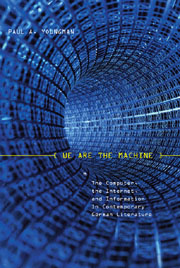Book contents
- Frontmatter
- Contents
- Preface
- Acknowledgments
- Introduction: Machines, Computers, and the Liberal Humanist Subject
- 1 Losing Ground to the Machine: Electronic Brains in the Works of Heinrich Hauser and Friedrich Dürrenmatt
- 2 Fearing the Machine — Two Nightmares in the 1990s: Gerd Heidenreich's New Riddle of the Sphinx and Barbara Frischmuth's Hidden Meaning
- 3 Becoming the Machine: Günter Grass's and Erich Loest's Virtual History, René Pollesch's Postdramatic Imaginings, and “Real” Cyber-Relationships according to Christine Eichel and Daniel Glattauer
- Conclusion: Questions to Ponder
- Bibliography
- Index
1 - Losing Ground to the Machine: Electronic Brains in the Works of Heinrich Hauser and Friedrich Dürrenmatt
Published online by Cambridge University Press: 05 February 2013
- Frontmatter
- Contents
- Preface
- Acknowledgments
- Introduction: Machines, Computers, and the Liberal Humanist Subject
- 1 Losing Ground to the Machine: Electronic Brains in the Works of Heinrich Hauser and Friedrich Dürrenmatt
- 2 Fearing the Machine — Two Nightmares in the 1990s: Gerd Heidenreich's New Riddle of the Sphinx and Barbara Frischmuth's Hidden Meaning
- 3 Becoming the Machine: Günter Grass's and Erich Loest's Virtual History, René Pollesch's Postdramatic Imaginings, and “Real” Cyber-Relationships according to Christine Eichel and Daniel Glattauer
- Conclusion: Questions to Ponder
- Bibliography
- Index
Summary
God dreamed man and created him. Then man was made and forgot God. Then man dreamed the machine and created the machine. And then one day the machine began to dream and forgot man.
— Dietmar Kamper, Philosophie und Naturwissenschaft. Essays, Gedichte und Reden (1980)The Dawn of the Computer Age
SINCE PAST IS PROLOGUE, I begin this look at the contemporary reception of IT with a view from the year 1941, the beginning of an era full of promise, but also rich with concerns when it came to the new “thinking machines.” We begin in this year because, as the reader will recall, it was the year in which Konrad Zuse completed his Z3 in Germany — “the first fully-automatic, program driven and freely programmable computer that used binary floating point computation” (Dietz 21). Zuse's computer was followed in close succession by the British mathematician Alan Turing's universal machine, realized in the form of Colossus — the machine hero of the Second World War — in 1943. And in the United States, two years later, John von Neumann, John Presper Eckert, John Mauchly, and their colleagues at the Moore School of Electrical Engineering defined the state of the art with the thirty-ton ENIAC — a grotesquely monstrous and slow machine by today's standards. This computer consisted of thirty separate units made of nearly 1,500 transistors, more than one hundred thousand resistors, inductors and capacitors, and 18,000 vacuum tubes, all of which provided a speed of logical switching never before seen in the nascent world of computing.
- Type
- Chapter
- Information
- We Are the MachineThe Computer, the Internet, and Information in Contemporary German Literature, pp. 28 - 61Publisher: Boydell & BrewerPrint publication year: 2009



